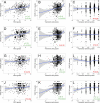Impact of integrating objective structured clinical examination into academic student assessment: Large-scale experience in a French medical school
- PMID: 33444375
- PMCID: PMC7808634
- DOI: 10.1371/journal.pone.0245439
Impact of integrating objective structured clinical examination into academic student assessment: Large-scale experience in a French medical school
Abstract
Purpose: Objective structured clinical examinations (OSCE) evaluate clinical reasoning, communication skills, and interpersonal behavior during medical education. In France, clinical training has long relied on bedside clinical practice in academic hospitals. The need for a simulated teaching environment has recently emerged, due to the increasing number of students admitted to medical schools, and the necessity of objectively evaluating practical skills. This study aimed at investigating the relationships between OSCE grades and current evaluation modalities.
Methods: Three-hundred seventy-nine 4th-year students of University-of-Paris Medical School participated to the first large-scale OSCE at this institution, consisting in three OSCE stations (OSCE#1-3). OSCE#1 and #2 focused on cardiovascular clinical skills and competence, whereas OSCE#3 focused on relational skills while providing explanations before planned cholecystectomy. We investigated correlations of OSCE grades with multiple choice (MCQ)-based written examinations and evaluations of clinical skills and behavior (during hospital traineeships); OSCE grade distribution; and the impact of integrating OSCE grades into the current evaluation in terms of student ranking.
Results: The competence-oriented OSCE#1 and OSCE#2 grades correlated only with MCQ grades (r = 0.19, P<0.001) or traineeship skill grades (r = 0.17, P = 0.001), respectively, and not with traineeship behavior grades (P>0.75). Conversely, the behavior-oriented OSCE#3 grades correlated with traineeship skill and behavior grades (r = 0.19, P<0.001, and r = 0.12, P = 0.032), but not with MCQ grades (P = 0.09). The dispersion of OSCE grades was wider than for MCQ examinations (P<0.001). When OSCE grades were integrated to the final fourth-year grade with an incremental 10%, 20% or 40% coefficient, an increasing proportion of the 379 students had a ranking variation by ±50 ranks (P<0.001). This ranking change mainly affected students among the mid-50% of ranking.
Conclusion: This large-scale French experience showed that OSCE designed to assess a combination of clinical competence and behavioral skills, increases the discriminatory capacity of current evaluations modalities in French medical schools.
Conflict of interest statement
The authors have declared that no competing interests exist.
Figures






Similar articles
-
Surgery Clerkship Evaluations Are Insufficient for Clinical Skills Appraisal: The Value of a Medical Student Surgical Objective Structured Clinical Examination.J Surg Educ. 2017 Mar-Apr;74(2):286-294. doi: 10.1016/j.jsurg.2016.08.018. Epub 2016 Sep 28. J Surg Educ. 2017. PMID: 27692808
-
OSCE as a tool for evaluation of practical semiology in comparison to MCQ & oral examination.J Pak Med Assoc. 2008 Sep;58(9):506-7. J Pak Med Assoc. 2008. PMID: 18846801
-
A pilot survey of student perceptions on the benefit of the OSCE and MCQ modalities.GMS J Med Educ. 2018 Nov 15;35(4):Doc51. doi: 10.3205/zma001197. eCollection 2018. GMS J Med Educ. 2018. PMID: 30539076 Free PMC article.
-
The Objective Structured Clinical Examination (OSCE) in the clinical clerkship: an overview.S D J Med. 1997 May;50(5):153-6. S D J Med. 1997. PMID: 9155233 Review.
-
An Innovative Evaluation in Fundamental Nursing Curriculum for Novice Nursing Students: An Observational Research.J Prof Nurs. 2018 Sep-Oct;34(5):412-416. doi: 10.1016/j.profnurs.2018.05.002. Epub 2018 May 2. J Prof Nurs. 2018. PMID: 30243698 Review.
Cited by
-
Impact of hospital internships on success in university summative objective structured clinical examinations: Large-scale experience in a French medical school.PLoS One. 2024 Jun 13;19(6):e0302427. doi: 10.1371/journal.pone.0302427. eCollection 2024. PLoS One. 2024. PMID: 38870194 Free PMC article.
-
Objective structured clinical examination versus traditional written examinations: a prospective observational study.BMC Med Educ. 2023 Jan 28;23(1):69. doi: 10.1186/s12909-023-04050-5. BMC Med Educ. 2023. PMID: 36707797 Free PMC article.
-
Clinical experience can compensate for inferior academic achievements in an undergraduate objective structured clinical examination.BMC Med Educ. 2023 Mar 16;23(1):167. doi: 10.1186/s12909-023-04082-x. BMC Med Educ. 2023. PMID: 36927361 Free PMC article.
-
Medical education in Latvia: an overview of current practices and systems.Front Med (Lausanne). 2023 Sep 21;10:1250138. doi: 10.3389/fmed.2023.1250138. eCollection 2023. Front Med (Lausanne). 2023. PMID: 37809335 Free PMC article.
-
A Scoping Review of Assessments in Undergraduate Medical Education: Implications for Residency Programs and Medical Schools.Acad Psychiatry. 2025 Jun;49(3):263-273. doi: 10.1007/s40596-025-02136-4. Epub 2025 Apr 1. Acad Psychiatry. 2025. PMID: 40169522 Free PMC article.
References
-
- O’Sullivan P, Chao S, Russell M, Levine S, Fabiny A. Development and implementation of an objective structured clinical examination to provide formative feedback on communication and interpersonal skills in geriatric training. J Am Geriatr Soc. 2008;56: 1730–1735. 10.1111/j.1532-5415.2008.01860.x - DOI - PubMed
MeSH terms
Associated data
LinkOut - more resources
Full Text Sources
Other Literature Sources

